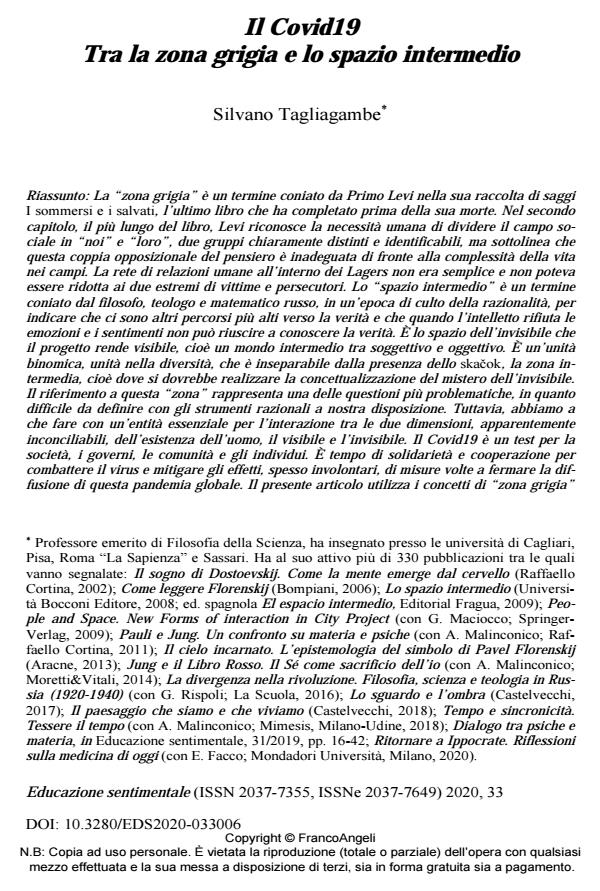Il Covid19.Tra la zona grigia e lo spazio intermedio
Journal title EDUCAZIONE SENTIMENTALE
Author/s Silvano Tagliagambe
Publishing Year 2020 Issue 2020/33 Language Italian
Pages 9 P. 28-36 File size 208 KB
DOI 10.3280/EDS2020-033006
DOI is like a bar code for intellectual property: to have more infomation
click here
Below, you can see the article first page
If you want to buy this article in PDF format, you can do it, following the instructions to buy download credits

FrancoAngeli is member of Publishers International Linking Association, Inc (PILA), a not-for-profit association which run the CrossRef service enabling links to and from online scholarly content.
The Covid19 between grey zone and intermediate space. The "grey zone" is a term coined by Primo Levi in his essay collection The Drowned and the Saved, the last book he completed before his death. In ‘The Grey Zone, the second chapter and the longest essay in the book, Levi acknowledges the human need to divide the social field into "us" and "them", two clear-ly distinct and identifiable groups, but points out that such binary thinking is inadequate in the face of the complexity of life in the camps. The network of human relationships inside the La-gers was not simple: it could not be reduced to the two blocs of victims and persecutors. The "intermediate space" is a term coined by the Russian philosopher, theologian and mathema-tician, in an era of the cult of rationality, to show that there are other, higher paths to truth and that when the intellect rejects emotions and feelings it cannot come to know truth. It is the space of the invisible that the project renders visible, i.e. an intermediate world between sub-jective and objective. It is a binomic unity, unity in diversity, which is inseparable from the presence of the skačok, the intermediate zone, i.e. were conceptualization of the mystery of the invisible should be realized. Reference to this "zone" represents one of the most problematic questions, as its difficult to define with the rational instruments at our disposal. Nevertheless, we are dealing with an essential entity for interaction between the two dimensions, apparently irreconcilable, of the existence of men, the visible and the invisible. Covid19 is a test of socie-ties, of governments, of communities and of individuals. It is a time for solidarity and cooper-ation to tackle the virus, and to mitigate the effects, often unintended, of measures designed to halt the spread of this global pandemic. The present paper uses the notions of "grey zone" and of "intermediate space" as keys to analyse the sudden and substantial impact of Covid19 on the culture and society.
Keywords: Grey zone, intermediate space, between, skačok, Covid19.
- Varchetta G. (2019). Un andare pensando. Primo Levi e la “zona grigia”. Prefazione di M. Belpoliti, Postfazione di E. Bruck. Milano-Udine: Mimesis.
- Canguilhem G. (1943). Essai sur quelques problèmes concernant le normal et le pathologique. Riedizione sotto il titolo: Le normal et le pathologique, augmenté de Nouvelles réflexions concernant le normal et le pathologique. Paris: Presses Universitaires de France, 1966. Tr. it.: Il normale e il patologico. Introduzione a cura di M. Porro, Postfazione a cura di M. Foucault. Torino: Einaudi, 1998.
- Cerasa C. (2020). La bellezza pura di quelli che restano. Il Foglio, 14 marzo 2020.
- Edinger E. (1960). The ego-self paradox. F. Analytical Psychology, 5:1, 1960. ID., Ego and Archetype. New York; Penguin, 1972.
- Florenskij P.A. (1922). Lo strumentario. In ID. Valentini N. e Gorelov A., a cura di, Il simbolo e la forma. Scritti di filosofia della scienza. Torino: Bollati Boringhieri, 2007.
- Florenskij P.A. (1999). Il timore di Dio. In: Valentini N. e Žak L., a cura e con Introduzione di, Il cuore cherubico. Scritti teologici e mistici. Tr. it. di R. Zugan. Casale Monferrato: Piemme.
- Florenskij P.A. (2010). Lezioni sulla concezione cristiana del mondo. In: Valentini N., a cura di, Bellezza e Liturgia. Milano: Oscar Mondadori.
- Jung C.G. (2010). Il libro rosso (Liber novus). A cura e con introduzione di Sonu Shamdasani. Torino: Bollati Boringhieri.
- Leonardo da Vinci (1490). Frammenti sull’architettura. Paris: MSS, Institut de France, 50r. In Bruschi A., a cura di, Scritti rinascimentali di architettura. Milano: Edizioni il Polifilo, 1978.
- Levi P. (1959). Arbeit macht frei. In: Opere II. Torino: Einaudi, 1990.
- Neumann E. (1959). The significance of the genetic aspect for analytical psychology. F. Analytical Psychology, 4:2, 1959.
Silvano Tagliagambe, Il Covid19.Tra la zona grigia e lo spazio intermedio in "EDUCAZIONE SENTIMENTALE" 33/2020, pp 28-36, DOI: 10.3280/EDS2020-033006